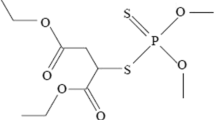Summary
Metabolic oxidative profiles of diazepam (I) were obtained by aromatic C-4′-hydroxylation, N-1-demethylation, and 3-hydroxylation using a supernatant of rat liver. Incubations of 3-methyldiazepam (VI), which suppressed 3-hydroxylation, and N-1-nor-3-methyldiazepam (VII), were used to separately investigate these three oxidative pathways. Treatment of animals with phenobarbital enhanced N-1-demethylation and 3-hydroxylation, and to a variable extent C-4′-hydroxylation. Application of metyrapone reduced metabolite formation by 3-hydroxylation and N-1-demethylation, but had no effect on C-4′-hydroxylation. Metyrapone inhibition was more pronounced following than prior to phenobarbital treatment. C-2-hydroxylation was studied using medazepam (XX) incubations. This pathway was increased by phenobarbital pretreatment and reduced by metyrapone inhibition which was again more pronounced following than prior to phenobarbital pretreatment.
These results support earlier conclusions on the heterogeneity of liver microsomes and suggest the presence of different species of hepatic microsomal terminal oxidases. Phenobarbital treatment and metyrapone change the metabolic profile via induction and inhibition, respectively, and, thus, in the case of 1,4-benzodiazepines, the formation of metabolites with varying pharmacological activity. This could become important in clinical situations as a diagnostic mean to determine induction under various treatment or, possibly, during cumulation of metabolites with a long half-life.
Similar content being viewed by others
References
Comai, K., Gaylor, J. L.: Existence and separation of three forms of cytochrome P-450 from rat liver microsomes. J. biol. Chem.248, 4947–4955 (1973)
Conney, A. H., Klutch, A.: Increased activity of androgen hydroxylases in liver microsomes of rats pretreated with phenobarbital and other drugs. J. biol. Chem.238, 1611–1617 (1963)
Conney, A. H., Lu, A. Y. H., Levin, W., Somogyi, A., West, S., Jacobson, M., Ryan, D., Kuntzman, R.: Effect of enzyme inducers on substrate specificity of the cytochrome P-450's. Drug Metab. and Disposition1, 199–210 (1973)
Daly, J., Jerina, D., Farnsworth, J., Guroff, G.: The migration of deuterium during aryl hydroxylation. II. The effect of induction of microsomal hydroxylases with phenobarbital or polycyclic hydrocarbons. Arch. Biochem. Biophys.131, 238–244 (1969).
Degkwitz, E., Ullrich, V., Staudinger, H. J., Rummel, W.: Metabolism and cytochrome P-450 binding spectra of (+)- and (-)-hexobarbital in rat liver microsomes. Hoppe-Seylers Z. physiol. Chem.350, 547–553 (1969)
Frommer, U., Ullrich, V., Staudinger, H. J.: Hydroxylation of aliphatic compounds by liver microsomes. II. The effect of phenobarbital induction in rats on specific activity and cytochrome P-450 substrate binding spectra. Hoppe-Seylers Z. physiol. Chem.351, 913–918 (1970)
Gillette, J. R.: Biochemistry of drug oxidation and reduction by enzymes in hepatic endoplasmic reticulum (Review). Advanc. Pharmacol.4, 219–261 (1966)
Haugen, D. A., van der Hoeven, T. A., Coon, M. J.: Purified liver microsomal cytochrome P-450 separation and characterization of multiple forms. J. biol. Chem.250, 3567–3570 (1975)
Hildebrandt, A. G., Leibman, K. C., Estabrook, R. W.: Metyrapone interaction with hepatic microsomal cytochrome PP-450 from rats treated with phenobarbital. Biochem. biophys. Res. Commun.37, 477–485 (1969)
Kröber, F., Lange, G., Mathes, S., G. Mohr: Quanlitative Änderungen in Lebermikrosomen Phenobarbital behandelter Kaninchen. Naunyn-Schmiedebergs Arch. Pharmak.267, 307–326 (1970)
Lange, G.: Verschiedene Induktion der mikrosomalen para- und N-Hydroxylierung von Anilin und N-Äthylanilinen bei Kaninchen. Naunyn-Schmiedebergs Arch. Pharmak. exp. Path.257, 230–256 (1967)
Lange, G., Thun, K. J.: Hydroxylierung von Progesteron durch Lebermikrosomen von Kaninchen. Änderung im Metabolitenmuster durch Phenobarbital-Behandlung der Tiere. Naunyn-Schmiedebergs Arch. Pharmak.267, 265–277 (1970)
Lu, A. Y. K., Kuntzman, R., West, S., Jacobson, M., Conney, A. H.: Reconstituted liver microsomal enzyme system that hydroxylates drugs, other foreign compounds and endogenous substrates. J. biol. Chem.247, 1727–1734 (1972)
Mannering, G. J.: Properties of cytochrome P-450 as affected by environmental factors: Qualitative changes due to administration of polycyclic hydrocarbons. Metab. Clin. exp.20, 228–245 (1971)
Netter, K. J., Kahl, G.-F., Magnussen, M. P.: Kinetic experiments on the binding of metyrapone to liver microsomes. Naunyn-Schmiedebergs Arch. Pharmak.265, 205–215 (1969)
Peterson, J. A., Ullrich, V., Hildebrandt, A. G.: Metyrapon interaction with pseudomonas putida cytochrome P-450. Arch. Biochem. Biophys.145, 531–542 (1971)
Remmer, H.: Induction of drug metabolizing enzyme system in the liver (Review). Europ. J. clin. Pharmacol.5, 116–136 (1972)
Rieder, J., Rentsch, G.: Metabolismus und Pharmakokinetik des neuen Psychopharmakons 7-Chlor-2,3-dihydro-1-methyl-5-phenyl-1H-1,4-benzodiazepin (Ro 5-4556) beim Menschen. Arzneimittel-Forsch.18, 1545–1556 (1968)
Roots, I., Hildebrandt, A. G.: Non-competitive and competitive inhibition of mixed function oxidase in rat liver microsomes by metyrapone. Naunyn-Schmiedeberg's Arch. Pharmacol.277, 27–38 (1973)
Sadée, W., Schwandt, H.-J., Beyer, K. H.: Zur Konformation unsymmetrisch substituierter 1,4-Benzodiazepin-2-one. Arch. Pharm. (Weinheim)306, 751–756 (1973)
Schwandt, H.-J.: Dissertation 1973, Freie Universität Berlin, Fachbereich Pharmazie. (Copies are available on request)
Schwandt, H.-J., Sadée, W., Beyer, K.-H.: Metabolic rearrangements of 1,4-benzodiazepine derivatives. Xenobiotica4, 733–741 (1974)
Schwartz, M. A., Bommer, P., Vane, F. M.: Diazepam metabolites in the rat: Characterization by high-resolution mass spectrometry and nuclear magnetic resonance. Arch. Biochem. Biophys.121, 508–516 (1967)
Schwartz, M. A., Carbone, J. J.: Metabolism of14C-medazepam hydrochloride in dog, rat, and man. Biochem. Pharmacol.19, 343–361 (1970)
Schwartz, M. A., Postma, E.: Metabolism of diazepam in vitro. Biochem. Pharmacol.17, 2443–2449 (1968)
Uehleke, H., Breyer, U., Budczies, B., Tabarelli, S., Hellmar, K.-H.: Der Einfluss von Metyrapon auf verschiedene Typen von mikrosomalen N-Oxidationen. Hoppe Seylers Z. physiol. Chem.325, 403–411 (1971)
Ullrich, V., Frommer, U., Weber, P.: Differences in the 0-dealkylation of 7-ethoxycoumarin after pretreatment with phenobarbital and 3-methylcholanthrene. Hoppe Seylers Z. physiol. Chem.354, 514–520 (1973)
Werringloer, J., Estabrook, R. W.: Heterogeneity of liver microsomal cytochrome P-450: The spectral characterization of reactants with reduced cytochrome P-450. Arch. Biochem. Biophys.167, 270–280 (1975)
Author information
Authors and Affiliations
Rights and permissions
About this article
Cite this article
Schwandt, H.J., Sadée, W., Beyer, K.H. et al. Effects of enzyme induction and inhibition on microsomal oxidation of 1,4-benzodiazepines. Naunyn-Schmiedeberg's Arch. Pharmacol. 294, 91–97 (1976). https://doi.org/10.1007/BF00692789
Received:
Accepted:
Issue Date:
DOI: https://doi.org/10.1007/BF00692789




